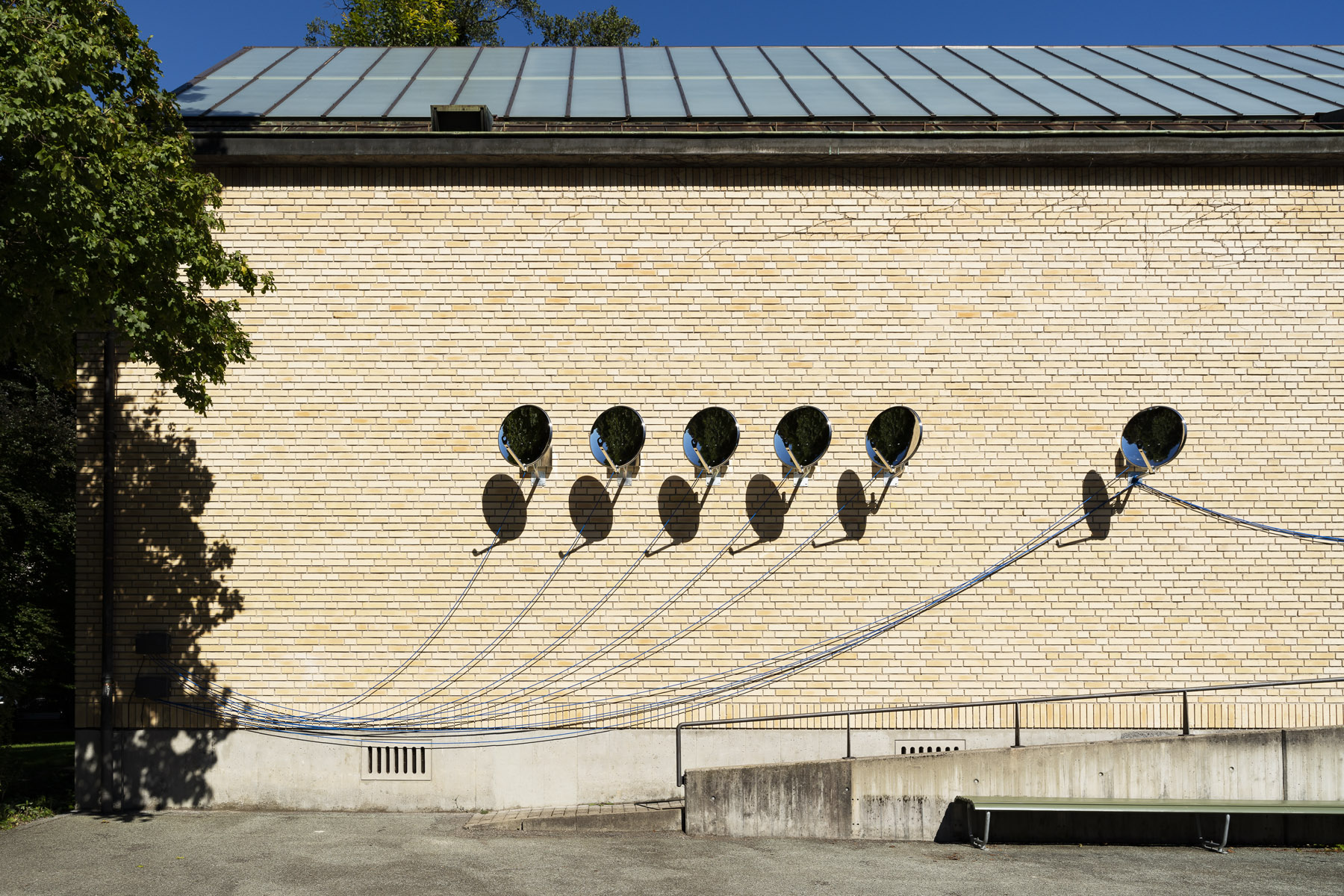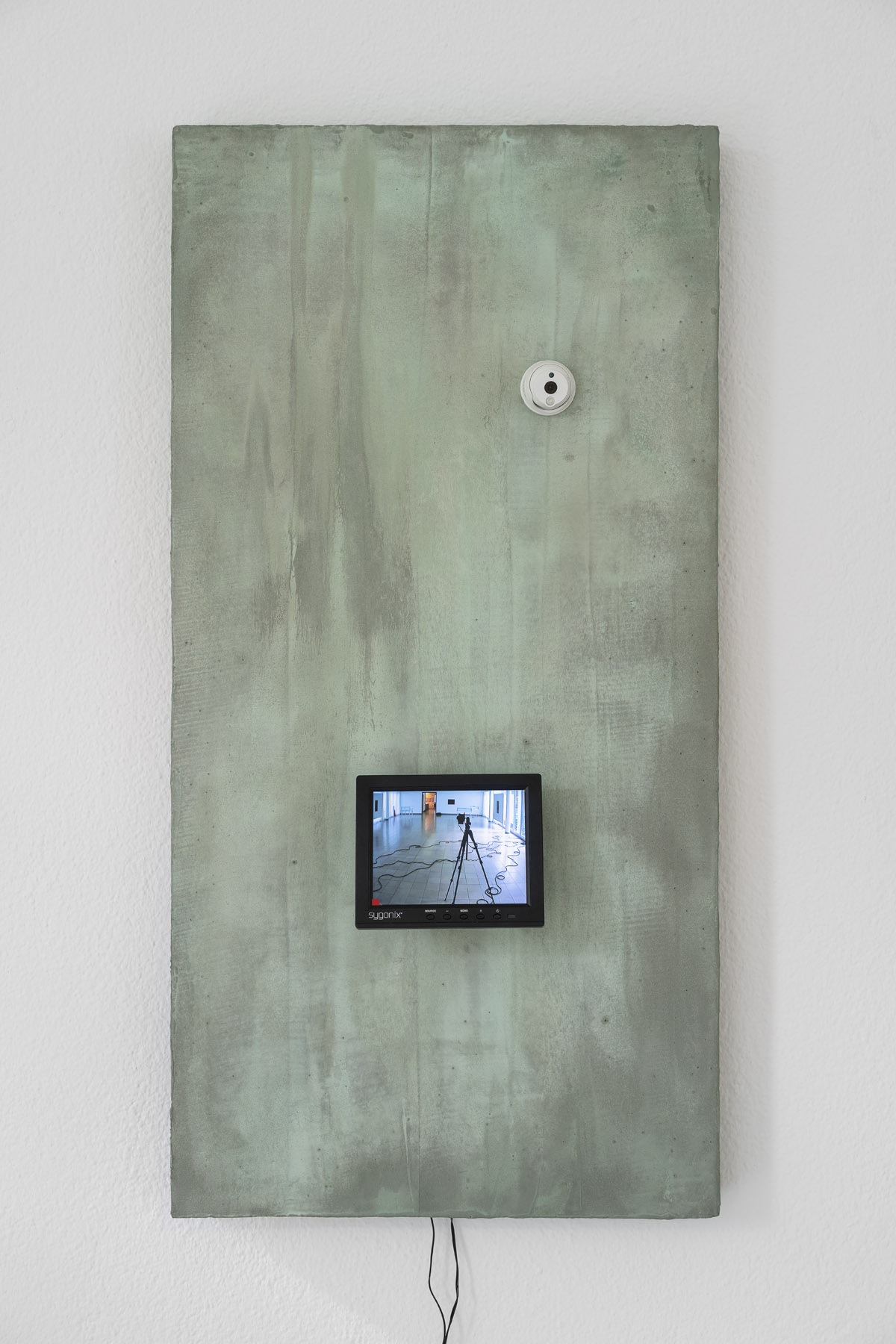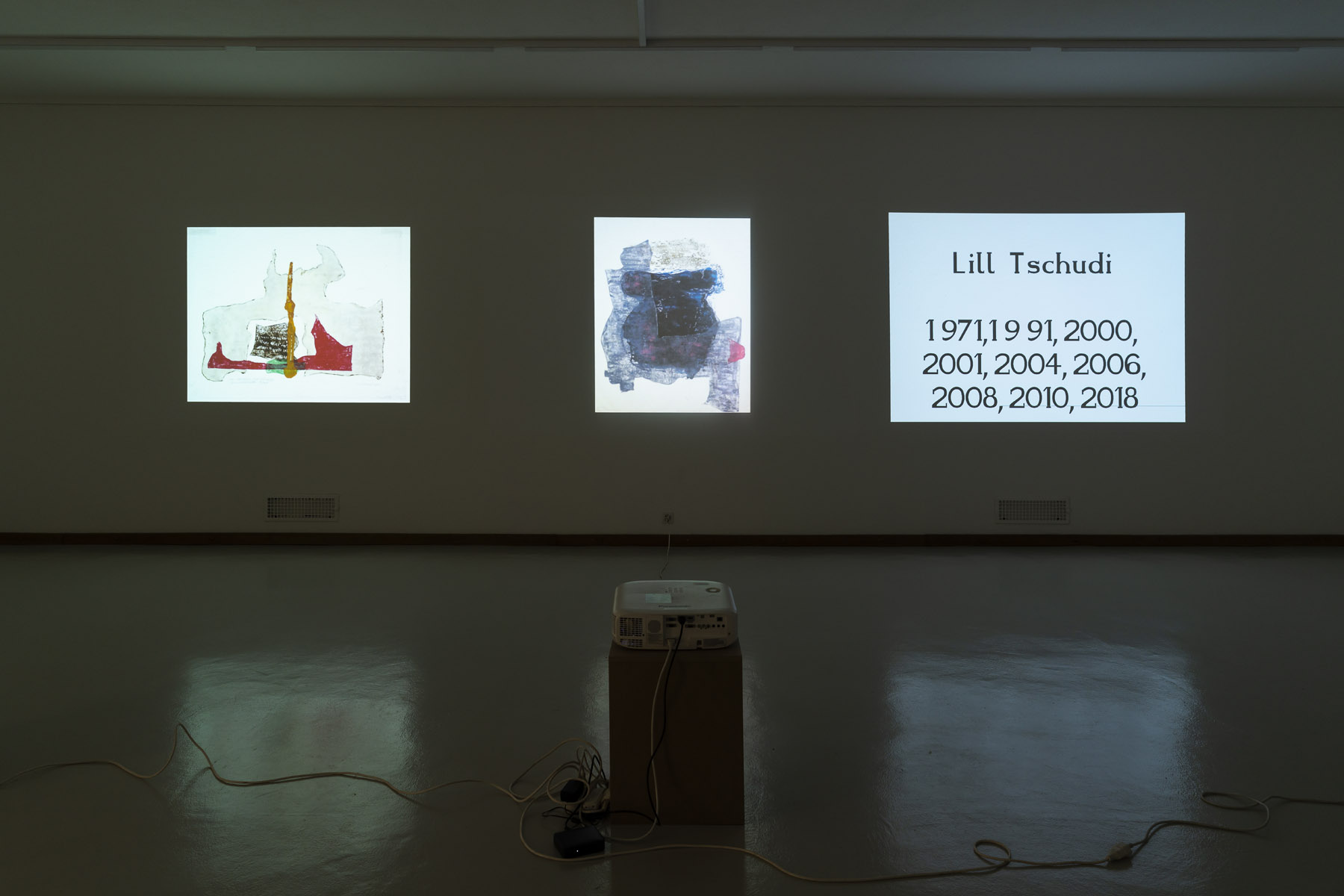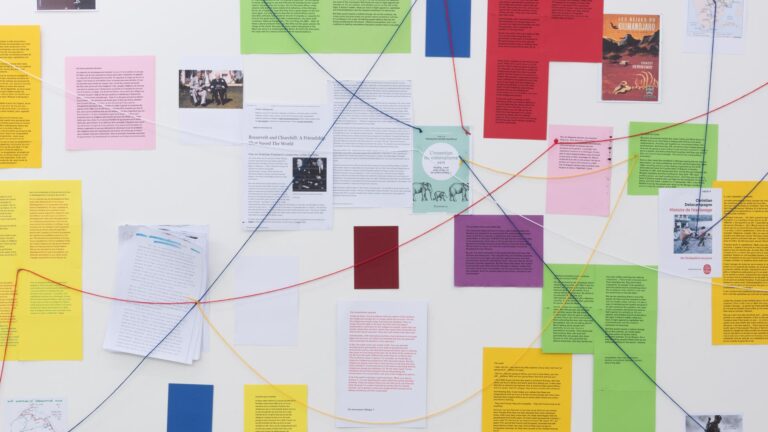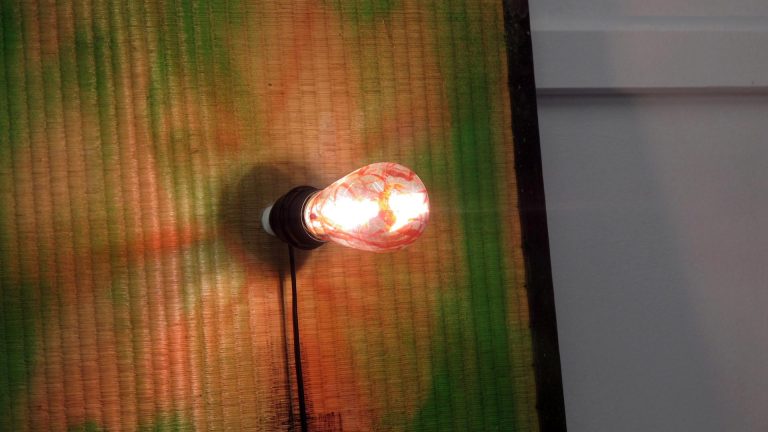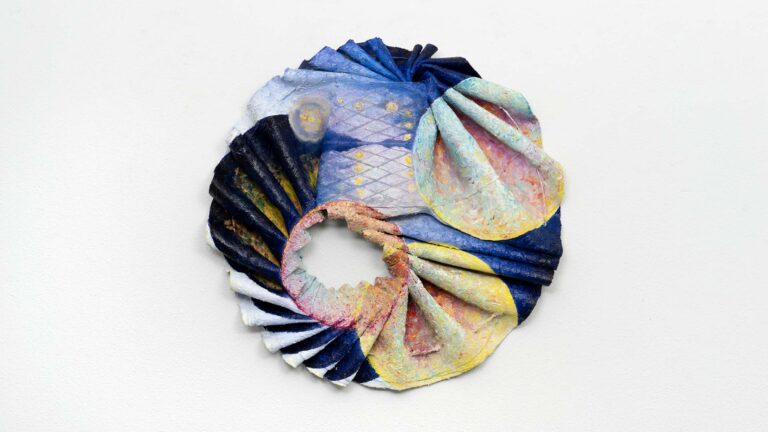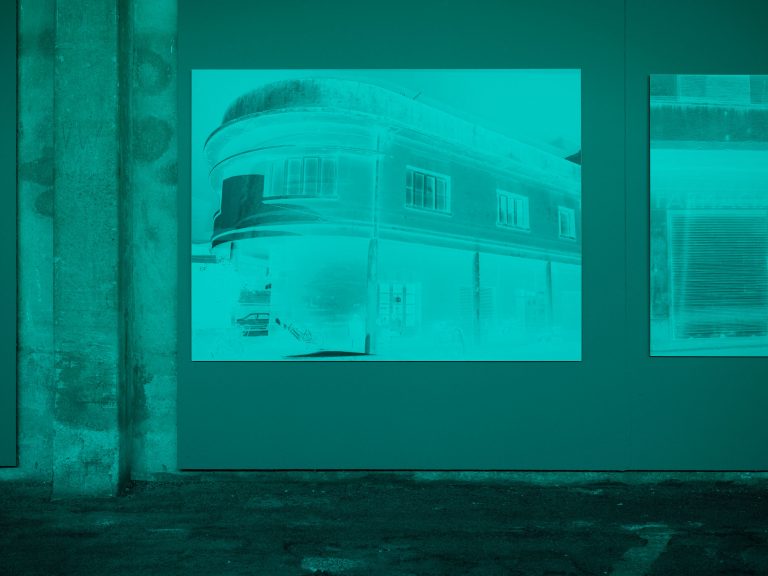Artists: Olivia Ali + Tobias Kaspar, Rachal Bradley, Trisha Donnelly, Richard Frater, Carissa Rodriguez, Julia Scher, Bea Schlingelhoff
Exhibition title: Im Volksgarten
Venue: Kunsthaus Glarus, Glarus, Switzerland
Date: September 5 – November 29, 2020
Photography: all images copyright and courtesy of the artists and Kunsthaus Glarus
Im Volksgarten has been the address of Kunsthaus Glarus since 1952; it serves as both street name and location description. Im Volksgarten, 8750 Glarus is also the title of a site-specific work by Maria Eichhorn, on view recently as a loan along with works from the Glarner Kunstverein collections. Painted nearly invisibly on the wall, the address declared the museum as a site that took temporary possession of the work. In the exhibition Im Volksgarten, the understanding of “possession” goes beyond the object and is returned to the space: it is about forms of taking possession of space, but also about fetishization and desire. How is the status of objects and things altered when they enter the museum? How do these things seduce us? What significance does the private and intimate have in this public realm. But also: what social or political and public meanings do we associate with the museum?
The two-winged modernist building of the museum is located at the edge of the Volksgarten, a lush city park that was stocked with exoticized flora at the end of the nineteenth century. It is idyllic and full of contrasts at the same time: life on the outside varies from that within. The Kunsthaus was renovated last year; the structure of the heritage-protected building was upgraded, refurbished and, where permitted, brought up to the latest technical standards. At the same time, infrastructural and safety regulations had to be implemented in publicly accessible areas. What kind of independent existence does the physical shell of the museum have? And, conversely, how do we, visitors and artists, hold sway over or control this shell? The museum must continually reexamine these questions without getting caught up in a state of idle institutional critique.
In their large-format installation coreOATK or Stop Reading My Art as the Story of My Life, Olivia Ali Tobias Kaspar (b. 1985 and b. 1984, lawyer and artist, both living in Zurich) outline the life of a fictitious character in abstract terms. The art-world context and its affiliated socio-economic ties provide the stage for this loose narrative. British artist Rachal Bradley (b. 1979, Blackpool, lives and works in London) is interested in the psychosocial properties of infrastructures that are continuously directed at their “inhabitants” and vice versa. On the exterior facade of Kunsthaus Glarus she has installed ominous receivers linking those individuals who are most often inside the museum by necessity to the world outside: its employees. Trisha Donnelly’s (b.
1974 San Francisco, lives and works in New York) artworks are often barely visible or perceptible and elude ostensibly valid patterns of observation and mediation. Here, sound often functions as a formative element that seeks out a life of its own within the spaces of the museum. Richard Frater (b. 1984, Wellington NZ, lives and works in Berlin) views the institution as a public space for uniting not only various social groups and interests but people and nature as well. The installation created for the exhibition brings into focus incompatibilities between the viewpoints of species that share habitats, as the architecture of the building makes clear. Carissa Rodriguez’s (b. 1970, New York, lives and works in New York) video installation The Maid (2018), presented for the first time in Switzerland, engages with modes of (re-) production and circulation of art. While artistic labor constantly interacts with the conditions of its production, the art object itself is related to different notions of (speculative) time. The film tracks six newborn sculptures by the artist Sherrie Levine at their various residencies, whereby the activation of existing material and social correlations is fundamental. Julia Scher (b. 1954 Hollywood, lives and works in Cologne) addresses in her work precepts of authority and control. Delta (2018/2020) forms a dysfunctional surveillance system linking the museum to the park. Bea Schlingelhoff (b. 1971, Waiblingen DE, lives and works in Zurich) lends a new form of visibility to a series of works from the Glarner Kunstverein collections, thus questioning the nature of the work and administrative activities associated with an art collection as well as its potential classification systems. Following her exhibition PAX (2019) at the Freulerpalast Museum des Landes Glarus, things have now come full circle at the Kunsthaus.
Rachal Bradley, Untitled, 2020, 10 chromed satellite dishes, 10 ionisers, aluminum di-bond housing, electrical wire cable and various hardware, dimensions varible. Courtesy the artist and Galerie Gregor Staiger, Zurich. Photo: Gunnar Meier
Rachal Bradley, Untitled (detail), 2020, 10 chromed satellite dishes, 10 ionisers, aluminum di-bond housing, electrical wire cable and various hardware, dimensions variable. Courtesy the artist and Galerie Gregor Staiger, Zurich. Photo: Gunnar Meier
Rachal Bradley, Untitled (detail), 2020, 10 chromed satellite dishes, 10 ionisers, aluminum di-bond housing, electrical wire cable and various hardware, dimensions variable. Courtesy the artist and Galerie Gregor Staiger, Zurich. Photo: Gunnar Meier
Rachal Bradley, Untitled (detail), 2020, 10 chromed satellite dishes, 10 ionisers, aluminum di-bond housing, electrical wire cable and various hardware, dimensions variable. Courtesy the artist and Galerie Gregor Staiger, Zurich. Photo: Gunnar Meier
Rachal Bradley, Untitled (detail), 2020, 10 chromed satellite dishes, 10 ionisers, aluminum di-bond housing, electrical wire cable and various hardware, dimensions variable. Courtesy the artist and Galerie Gregor Staiger, Zurich. Photo: Gunnar Meier
Rachal Bradley, Untitled (detail), 2020, 10 chromed satellite dishes, 10 ionisers, aluminum di-bond housing, electrical wire cable and various hardware, dimensions variable. Courtesy the artist and Galerie Gregor Staiger, Zurich. Photo: Gunnar Meier
Carissa Rodriguez, All the Best Memories are Hers, 2018, silver gelatin print from LVT Negative, 29.2 x 31.8 cm. Courtesy the artist. Photo: Gunnar Meier
Carissa Rodriguez, All the Best Memories are Hers, 2018, silver gelatin print from LVT Negative, 29.2 x 31.8 cm. Courtesy the artist. Photo: Karma International, Zurich
Im Volksgarten, Kunsthaus Glarus, 2020, installation view. Carissa Rodriguez, The Maid, 2018, 4K video (color, sound), 12:22 min. Courtesy the artist. Photo: Gunnar Meier
Im Volksgarten, Kunsthaus Glarus, 2020, installation view. Carissa Rodriguez, The Maid, 2018, 4K video (color, sound), 12:22 min. Courtesy the artist. Photo: Gunnar Meier
Carissa Rodriguez, The Maid (Videostill), 2018, 4K video (color, sound), 12:22 min. Courtesy the artist. Still: Carissa Rodriguez
Carissa Rodriguez, The Maid (Videostill), 2018, 4K video (color, sound), 12:22 min. Courtesy the artist. Still: Carissa Rodriguez
Carissa Rodriguez, The Maid (Videostill), 2018, 4K video (color, sound), 12:22 min. Courtesy the artist. Still: Carissa Rodriguez
Im Volksgarten, Kunsthaus Glarus, 2020, installation view. Julia Scher, Delta, 2018, concrete mix coated insulation boards, hygrometer, camera, hard disk, LED, cables, 8 parts each 120 x 60 cm. Courtesy the artist and DREI, Cologne / Esther Schipper, Berlin. Photo: Gunnar Meier
Julia Scher, Delta (detail), 2018, concrete mix coated insulation boards, hygrometer, camera, hard disk, LED, cables, 8 parts each 120 x 60 cm. Courtesy the artist and DREI, Cologne / Esther Schipper, Berlin. Photo: Gunnar Meier
Julia Scher, Delta (detail), 2018, concrete mix coated insulation boards, hygrometer, camera, hard disk, LED, cables, 8 parts each 120 x 60 cm. Courtesy the artist and DREI, Cologne / Esther Schipper, Berlin. Photo: Gunnar Meier
Julia Scher, Delta (detail), 2018, concrete mix coated insulation boards, hygrometer, camera, hard disk, LED, cables, 8 parts each 120 x 60 cm. Courtesy the artist and DREI, Cologne / Esther Schipper, Berlin. Photo: Gunnar Meier
Julia Scher, Delta (detail), 2018, concrete mix coated insulation boards, hygrometer, camera, hard disk, LED, cables, 8 parts each 120 x 60 cm. Courtesy the artist and DREI, Cologne / Esther Schipper, Berlin. Photo: Gunnar Meier
Julia Scher, Delta (detail), 2018, concrete mix coated insulation boards, hygrometer, camera, hard disk, LED, cables, 8 parts each 120 x 60 cm. Courtesy the artist and DREI, Cologne / Esther Schipper, Berlin. Photo: Gunnar Meier
Julia Scher, Delta, 2020, concrete mix coated insulation boards, camera, LED, cables, 3 parts each 60 x 40 cm. Courtesy the artist and DREI, Cologne / Esther Schipper, Berlin. Photo: Gunnar Meier
Im Volksgarten, Kunsthaus Glarus, 2020, installation view. Richard Frater, Einladungsdilemma, 2020. Courtesy the artist. Photo: Gunnar Meier
Im Volksgarten, Kunsthaus Glarus, 2020, installation view. Richard Frater, Einladungsdilemma, 2020. Courtesy the artist. Photo: Gunnar Meier
Richard Frater, Not yet titled I (Akademie der Künste, Hansaviertel), 2020. Courtesy the artist. Photo: Richard Frater
Richard Frater, Einladungsdilemma (detail), 2020 / On and under the vitrine: Richard Frater, For Rewi Thompson, 2020, Collodion wet plate ambrotype, two glass assemblages, modified Purimu cockle shells, paper, limb, cord, dimensions variable. Courtesy the artist. Photo: Gunnar Meier
Richard Frater, Variation B, 2020, C-type on matt paper / On the vitrine: Richard Frater, For Rewi Thompson (detail), 2020, Collodion wet plate ambrotype, two glass assemblages, modified Purimu cockle shells, dimensions variable. Courtesy the artist. Photo: Gunnar Meier
Richard Frater, For Rewi Thompson (Detail), 2020, Collodion wet plate ambrotype, two glass assemblages, modified Purimu cockle shells, Papier, Ast, Schnur, dimension variable. Courtesy the artist. Photo: Gunnar Meier
Richard Frater, For Rewi Thompson (Detail), 2020, Collodion wet plate ambrotype, two glass assemblages, modified Purimu cockle shells, Papier, Ast, Schnur, dimension variable. Courtesy the artist. Photo: Gunnar Meier
Richard Frater, Variation A, 2020, C-type on matt paper. Courtesy the artist. Photo: Gunnar Meier
Richard Frater, Not yet titled II (Akademie der Künste, Hansaviertel), 2020. Courtesy the artist. Photo: Richard Frater
Richard Frater, Not yet titled III (Akademie der Künste, Hansaviertel), 2020. Courtesy the artist. Photo: Richard Frater
Im Volksgarten, Kunsthaus Glarus, 2020, installation view. Richard Frater, Einladungsdilemma, 2020. Courtesy the artist. Photo: Gunnar Meier
Richard Frater, Variation A, 2020, C-type on matt paper. Courtesy the artist. Photo: Gunnar Meier
Olivia Ali + Tobias Kaspar, coreOATK_01, 2020, from coreOATK or Stop Reading my Art as the Story of my Life, 2020, gypsophila, OASIS foam, 485 x 800 x 60 cm. Courtesy the artists and Gallery Peter Kilchmann, Zurich. Photo: Gunnar Meier
Olivia Ali + Tobias Kaspar, coreOATK_01 (detail), 2020, from coreOATK or Stop Reading my Art as the Story of my Life, 2020, gypsophila, OASIS foam, 485 x 800 x 60 cm. Courtesy the artists and Gallery Peter Kilchmann, Zurich. Photo: Gunnar Meier
Olivia Ali + Tobias Kaspar, coreOATK_01, 2020, from coreOATK or Stop Reading my Art as the Story of my Life, 2020, gypsophila, OASIS foam, 485 x 800 x 60 cm. Courtesy the artists and Gallery Peter Kilchmann, Zurich. Photo: Gunnar Meier
Im Volksgarten, Kunsthaus Glarus, 2020, installation view. Olivia Ali + Tobias Kaspar, 50 reasons, 2020, from coreOATK or Stop Reading my Art as the Story of my Life, 2020, 50 sanitary facilities (ceramics), white fabric, 900 x 800 x 60 cm. Courtesy the artists and Gallery Peter Kilchmann, Zurich. Photo: Gunnar Meier
Im Volksgarten, Kunsthaus Glarus, 2020, installation view. Olivia Ali + Tobias Kaspar, 50 reasons, 2020, from coreOATK or Stop Reading my Art as the Story of my Life, 2020, 50 sanitary facilities (ceramics), white fabric, 900 x 800 x 60 cm. Courtesy the artists and Gallery Peter Kilchmann, Zurich. Photo: Gunnar Meier
Olivia Ali + Tobias Kaspar, 50 reasons (detail), 2020, from coreOATK or Stop Reading my Art as the Story of my Life, 2020, 50 sanitary facilities (ceramics), white fabric, 900 x 800 x 60 cm. Courtesy the artist and Gallery Peter Kilchmann, Zurich. Photo: Gunnar Meier
Im Volksgarten, Kunsthaus Glarus, 2020, installation view. Olivia Ali + Tobias Kaspar, 50 reasons, 2020, from coreOATK or Stop Reading my Art as the Story of my Life, 2020, 50 sanitary facilities (ceramics), white fabric, 900 x 800 x 60 cm. Courtesy the artists and Gallery Peter Kilchmann, Zurich. Photo: Gunnar Meier
Im Volksgarten, Kunsthaus Glarus, 2020, installation view. Olivia Ali + Tobias Kaspar, 50 reasons, 2020, from coreOATK or Stop Reading my Art as the Story of my Life, 2020, 50 sanitary facilities (ceramics), white fabric, 900 x 800 x 60 cm. Courtesy the artists and Gallery Peter Kilchmann, Zurich. Photo: Gunnar Meier
Im Volksgarten, Kunsthaus Glarus, 2020, installation view. Julia Scher, Delta, 2018, 5 Amazon Alexas, fake Alexa, cables, sound, size variable. Courtesy the artist and DREI, Cologne / Esther Schipper, Berlin. Photo: Gunnar Meier
Im Volksgarten, Kunsthaus Glarus, 2020, installation view. Julia Scher, Delta, 2018, 5 Amazon Alexas, fake Alexa, cables, sound, size variable. Courtesy the artist and DREI, Cologne / Esther Schipper, Berlin. Photo: Gunnar Meier
Olivia Ali + Tobias Kaspar, Lost in Messenger, 2020, from coreOATK or Stop Reading my Art as the Story of my Life, 2020, 8 frames with photographs and silkscreen text on matt board, shelf with various objects, 300 x 200 x 30 cm. Courtesy the artist and Gallery Peter Kilchmann, Zurich. Photo: Gunnar Meier
Olivia Ali + Tobias Kaspar, Lost in Messenger (detail), 2020, from coreOATK or Stop Reading my Art as the Story of my Life, 2020, 8 frames with photographs and silkscreen text on matt board, shelf with various objects, 300 x 200 x 30 cm. Courtesy the artist and Gallery Peter Kilchmann, Zurich. Photo: Gunnar Meier
Olivia Ali + Tobias Kaspar, Lost in Messenger (detail), 2020, from coreOATK or Stop Reading my Art as the Story of my Life, 2020, 8 frames with photographs and silkscreen text on matt board, shelf with various objects, 300 x 200 x 30 cm. Courtesy the artist and Gallery Peter Kilchmann, Zurich. Photo: Gunnar Meier
Im Volksgarten, Kunsthaus Glarus, 2020, installation view. Kunsthaus Glarus X Bea Schlingelhoff, Presentation Roulette (318 works in custodial care of the collections Glarner Kunstverein: thereof 67 acquisitions, 47 donations, 9 annual gifts, 2 legal estates, 1 deposit, 1 collection of sketchbooks, further 192 specifications are in process), 2020, JPEGs, typeface Olga Oppenheimer, catalog of works. Courtesy the artist. Photo: Gunnar Meier
Im Volksgarten, Kunsthaus Glarus, 2020, installation view. Kunsthaus Glarus X Bea Schlingelhoff, Presentation Roulette (318 works in custodial care of the collections Glarner Kunstverein: thereof 67 acquisitions, 47 donations, 9 annual gifts, 2 legal estates, 1 deposit, 1 collection of sketchbooks, further 192 specifications are in process), 2020, JPEGs, typeface Olga Oppenheimer, catalog of works. Courtesy the artist. Photo: Gunnar Meier
Im Volksgarten, Kunsthaus Glarus, 2020, installation view. Kunsthaus Glarus X Bea Schlingelhoff, Presentation Roulette (318 works in custodial care of the collections Glarner Kunstverein: thereof 67 acquisitions, 47 donations, 9 annual gifts, 2 legal estates, 1 deposit, 1 collection of sketchbooks, further 192 specifications are in process), 2020, JPEGs, typeface Olga Oppenheimer, catalog of works. Courtesy the artist. Photo: Gunnar Meier
Kunsthaus Glarus X Bea Schlingelhoff, Presentation Roulette (318 works in custodial care of the collections Glarner Kunstverein: thereof 67 acquisitions, 47 donations, 9 annual gifts, 2 legal estates, 1 deposit, 1 collection of sketchbooks, further 192 specifications are in process) (detail), 2020, JPEGs, typeface Olga Oppenheimer, catalog of works. Courtesy the artist. Photo: Gunnar Meier



